Dryopteris
This genus, which includes the buckler and the male ferns, makes perhaps the largest contribution of all to our garden flora. Most species of Dryopteris are large, strong, woodland ferns, easy to grow and quick to make a solid impression.
D. aemula (W) hay-scented buckler fern Hight/Spread 50cm or more.
Thought by some to be our most beautiful native fern, D. aemula is a lovely wintergreen, medium-sized fern with delicate tripinnate fronds, which requires a lime-free soil. It is not always readily available but is well worth the search, as good ferns in this size range are not common. 50cm.
|
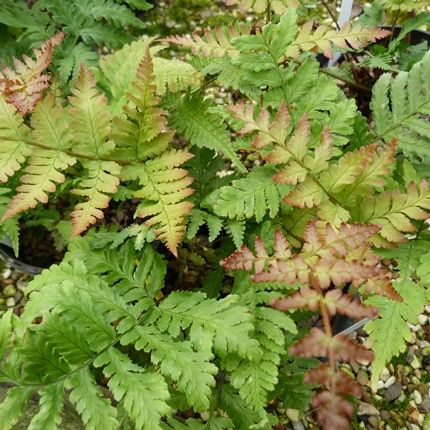
|
D. cycadina AGM (W) Hight/Spread 80cm
A pinnate fern with unusual, large pinnae, having soft spines on their edges and attached to hairy black rachis. The foliage is said to look like that of a cycad. A very striking and popular plant when mature, but small potted plants of this species rarely impress, so it is less often grown than it might be. Easy in most places. It is sometimes sold under the name of D. atrata, which is a very rare fern, so it will most likely be D. cycadina which you will be offered for sale under that name.
|
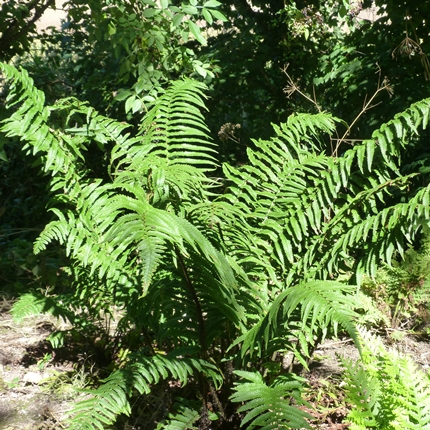
|
D. dilatata AGM (W) (syn. D. austriaca) broad buckler fern Hight/Spread 100cm or more.
A robust, tripinnate, British fern, broad and generous in appearance, but not invasive. This is one of the commonest ferns in the wild, and is characteristic of Britain’s forestry plantations, but it should not be despised for that. It is a first-class garden plant, easy in any shady place, and evergreen in mild winters, and with several good forms, though they are usually less vigorous than the type: ‘Lepidota Crispa Cristata’ with crispy (pinnae having curled edges) and crested fronds, even more beautiful than the type; ‘Crispa Whiteside’ AGM, a vigorous form with slightly crispy fronds giving it a wrinkly look; ‘Grandiceps’, with a large crest at the end of the frond is a good hansom form.
|
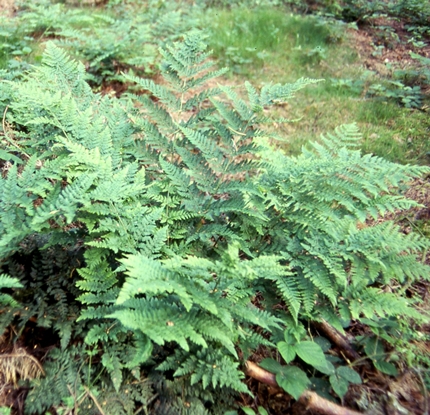
|
D. erythrosora AGM (E) autumn fern Hight/Spread 60cm.
One of the best known ferns, with broad leathery bipinnate, slightly shiny new fronds which emerge cherry red, fade to copper, then salmon, and finally turn olive green. A native of Asia, it needs shade and humus-rich soil, particularly resenting wind. Some people struggle with this fern while for others it grows easily, I am not sure why, but different strains certainly have different degrees of hardiness and there may be a number of subspecies which are not separated in the trade, so if D. erythrosora fails for you, it may be a good idea to try one from a different source. D. erythrosora 'Brilliance' is especially colourful but is not one of the hardier cultivars, and needs shelter.
Dryopteris lepidopoda (D) Sunset Fern Hight/Spread 80cm
A bipinnate fern newly introduced from Asia, very like D. wallichiana in appearance except that it has pink flushed fronds. Seems easy in cultivation.
|
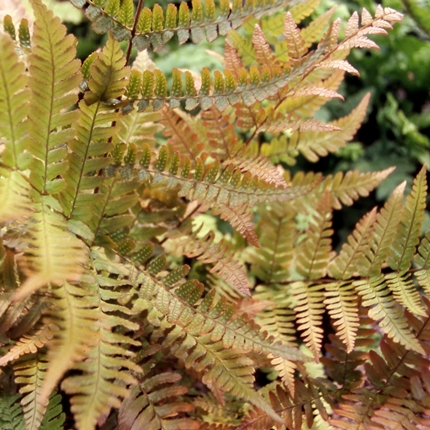
|
D. wallichiana AGM (W) Hight/Spread 80cm.
Black hairy rachises and golden green bipinnate fronds make a really beautiful fern and much requested in the nursery. It needs shade and a good, humus-rich soil, but like many plants from the Himalaya can be difficult, especially in pots or on chalk soil. The frond colour may turn to dark green on rich acid soils, where presumably it is most happy. |

|
Dryopteris uniformis. (W) Hight/Spread 80cm.
A delightful new introduction from Asia, which has tough leathery bipinnate fronds with striking black scales on the rachis and croziers. The form I grow is 'Cristata' which has slight and interesting, if not very prominent, cresting on the frond edges. It seems to be a very hardy fern which should thrive in the coldest areas, and is quite happy growing strongly in dry shade on my chalk soil. |
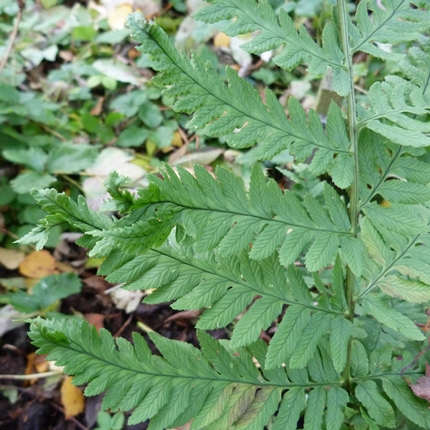
|
|